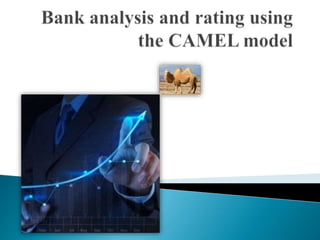
Bank analysis and rating using the CAMEL model
- 2. A rating system for domestic and foreign banks based on the international CAMELS model combining financial management and systems and control elements was introduced for the inspection cycle commencing from July 1998. CAMELS evaluates banks on the following six parameters
- 3. Capital adequacy Asset quality Management Earnings Liquidity Sensitivity to market
- 4. The purpose of CAMELS ratings is to determine a bank’s overall condition and to identify its strengths and weaknesses: Financial Operational Managerial
- 5. Each element is assigned a numerical rating based on five key components: 1 Strong performance, sound management, no cause for supervisory concern 2 Fundamentally sound, compliance with regulations, stable, limited supervisory needs 3 Weaknesses in one or more components, unsatisfactory practices, weak performance but limited concern for failure 4 Serious financial and managerial deficiencies and unsound practices. Need close supervision and remedial action 5 Extremely unsafe practices and conditions, deficiencies beyond management control. Failure is highly probable and outside financial assistance needed
- 6. Bank supervisory authorities assign each bank a score on a scale of 1 (best) to 5 (worst) for each factor. If a bank has an average score less than 2 it is considered to be a high-quality institution while banks with scores greater than 3 are considered to be less-than-satisfactory establishments. The system helps the supervisory authority identify banks that are in need of attention.
- 7. Capital adequacy is measured by the ratio of capital to risk-weighted assets . A sound capital base strengthens confidence of depositors.
- 8. Nature and volume of assets in relation to total capital and adequacy other reserves Balance sheet structure including off balance sheet items, market and concentration risk Nature of business activities and risks to the bank Asset and capital growth experience and prospects Earnings performance and distribution of dividends Capital requirements and compliance with regulatory requirements Access to capital markets and sources of capital
- 9. One of the indicators for asset quality is the ratio of non-performing loans to total loans (GNPA). The gross non-performing loans to gross advances ratio is more indicative of the quality of credit decisions made by bankers. Higher GNPA is indicative of poor credit decision-making. Asset represents all the assets of the bank, current and fixed, loan portfolio, investments and real estate owned as well as off balance sheet transactions
- 10. Asset quality is based on the following considerations: Volume of problem of all assets Volume of overdue or rescheduled loans Ability of management to administer all the assets of the bank and to collect problem loans Large concentrations of loans and insiders loans, diversification of investments Loan portfolio management, written policies, procedures internal control, Management Information System Loan Loss Reserves in relation to problem credits and other assets Growth of loans volume in relation to the bank’s capacity
- 11. Management includes all key managers and the Board of Directors
- 12. Management is the most important element for a successful operation of a bank. Rating is based on the following factors: Quality of the monitoring and support of the activities by the board and management and their ability to understand and respond to the risks associated with these activities in the present environment and to plan for the future Development and implementation of written policies, procedures, MIS, risk monitoring system, reporting, safeguarding of documents, contingency plan and compliance with laws and regulations controlled by a compliance officer Availability of internal and external audit function Concentration or delegation of authority Compensations policies, job descriptions Overall performance of the bank and its risk profile
- 13. All income from operations, non-traditional sources, extraordinary items It can be measured as the the return on asset ratio
- 14. Earnings are rated according to the following factors: Sufficient earnings to cover potential losses, provide adequate capital and pay reasonable dividends Composition of net income. Level of expenses in relation to operations Reliance on extraordinary items, securities transactions, high risk activities Non traditional or operational sources Adequacy of budgeting, forecasting, control MIS of income and expenses Adequacy of provisions Earnings exposure to market risks, such as interest rate variations, foreign exchange fluctuations and price risk
- 15. Cash maintained by the banks and balances with central bank, to total asset ratio is an indicator of bank's liquidity. In general, banks with a larger volume of liquid assets are perceived safe, since these assets would allow banks to meet unexpected withdrawals.
- 16. Liquidity is rated based on the following factors: Sources and volume of liquid funds available to meet short term obligations Volatility of deposits and loan demand Interest rates and maturities of assets and liabilities Access to money market and other sources of funds Diversification of funding sources Reliance on inter-bank market for short term funding Management ability to plan, control and measure liquidity process. Contingency plan
- 17. Sensitivity to market risks is not taken into consideration by CBI.
- 18. Market risk is based primarily on the following evaluation factors: Sensitivity to adverse changes in interest rates, foreign exchange rates, commodity prices, fixed assets ◦ Nature of the operations of the bank ◦ Trends in the foreign currencies exposure ◦ Changes in the value of the fixed assets of the bank ◦ Importance of real estate assets resulting from loans write off
